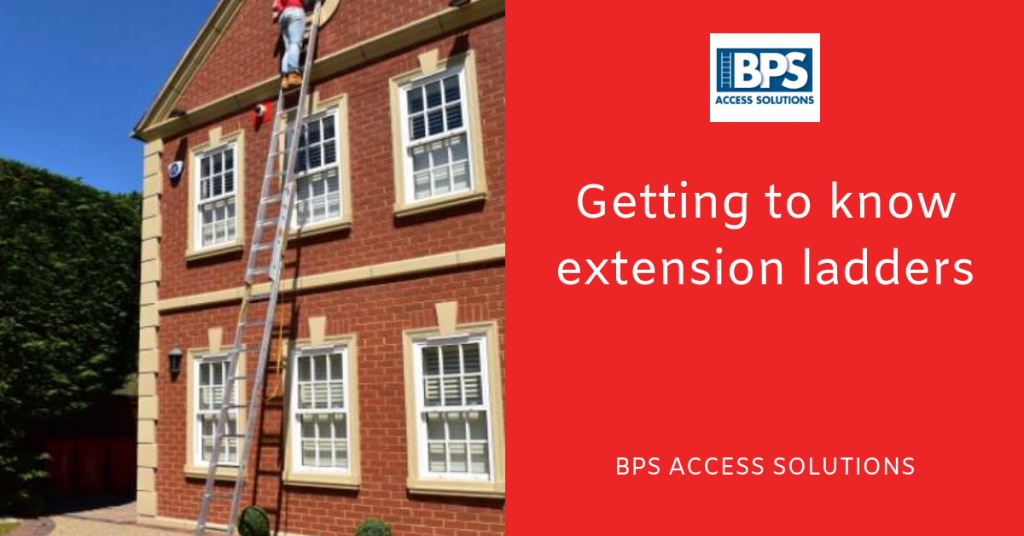Getting to know Extension Ladders
1) Make sure you understand the different parts of the extension ladder. These are important components of the ladder that must be assembled and handled correctly.
- The safety shoe or foot of the ladder, are the pads that rest on the ground/floor and provide additional grounding support while the ladder is under strain. These may rotate to increase their surface area and make the ladder more stable.
- The extendable section is the part of the ladder allowing a higher reach for the user. Be aware that some extension ladders may extend more than once and could have a total of three ladder sections.
- The base section is the section of the ladder that is closest to the ground and that the extensions are attached to. When ascending the ladder, you will start at this point of the ladder from the rungs.
- The rung lock is secured to the extendable section and is designed to hold to ladder together when the extensions are required. This allows the user to safely climb the ladder without risk of it separating.
- The rope and cord are only necessary for the longest of ladders and smaller ladders will not require them to be usable, however, larger ladders will be unusable without the rope and cord system in place.
2) You must be aware of the importance of using a ladder safety. Accidents with ladders are common and more importantly can cause very serious injuries that could be life threating or worse, fatal. Taking the time to read the safety warnings could save your life.
- Ladders, including extension ladders, are typical for having only two legs which touch the ground and provide stability. Some ladders may have three or four and provide even more stability. However, most ladders do not, so be sure to take that into account when up against the ladder.
- Extension ladders are of course longer than standard ladders, which is useful but also increases the risks, both with greater height and weight/balance distribution concerns, the taller the ladder and the higher you are the more at risk you are.
- It is common for extension ladders to be incorrectly used, it is vital that at least two people are involved in the operation of the ladder, one to climb and the other to remain on the ground to provide extra support and grounding which will be required. Extension ladders must only be vertical and not horizontal. Leaning and supporting the ladder on another object is also advisable yet this must be secure.
- Be aware of the limits of the ladder, different ladders are capable of supporting the different amount of weight, this is something you need to be aware of before you use it, as the ladder in question may be unable to cope with your needs. The ladder classification systems are numerous and can be confusing, so take the time to find out more before you use the ladder if you are unfamiliar with it. New ladders should have the necessary labels to assist you.
3) Assembly and climbing the ladder
- When you are ready to use it. check the ladder before climbing. Damage to any part of the ladder could make it too dangerous for use, including the rungs, rung locks, extendable section and cord.
- Move the ladder. The ladder should be locked into position by the rung locks or another safe alternative. If the extension is loose when carried it caused cause painful and serious damage to the fingers and hands if they are in the way of the moving extension.
- Place the ladder where you want to climb. Do this before extending the ladder and make sure to position the ladder upon the base of the ladder. The majority of extension ladders extend from the base and from the nearside/climbing side, allowing you to climb between the base and the extension smoothly.
- Be aware that to be at the correct and safe angle to climb, the base of the ladder must be spaced ¼ of the height (of the ladder) away from the building that it is leaning on. For instance, if the full height of the ladder is 12 feet or 3.66m, then the base of the ladder should be placed 3 feet or 0.914m away from the building.
- Raising the extendable section, your ladder may be equipped with a cord, if so, simply pull the rope and the extension will move upwards. If not, you will need to move it manually.
- While the extendable section is in motion, ensure that the base of the ladder is grounded and that one, if not more people are holding both rails on the ground to ensure maximum stability. If the weather conditions are not pleasant when using the ladder, be most careful when extending and using the ladder. If you are planning to work on or examine a roof, then be sure to extend the ladder to at least 3 feet or 9.14m over the height of the roof you will be at.
- Secure the extendable section in position with the rung locks. This will prevent it from sliding down while you are climbing.
- Lower the ladder slowly to the structure, remembering to keep a foot on the base of the ladder to prevent it from slipping while you position in against the structure. When in position, make sure that both sides of the ladder are stable and steady against the surface. If this is not done, then the ladder must not be climbed as it will be unstable and could cause you to fall and injure yourself.
- When climbing the ladder don’t forget to climb it one step at a time to maintain your balance and to help the person on the ground provide balance. Use both hands to help you climb the ladder and do not carry anything as this will make holding on difficult. A tool belt or other apparatus should be used to carry anything you need when on the ladder. Ensure that the top end of the ladder is securely fastened to the structure to prevent it and you from falling.
No related posts.



